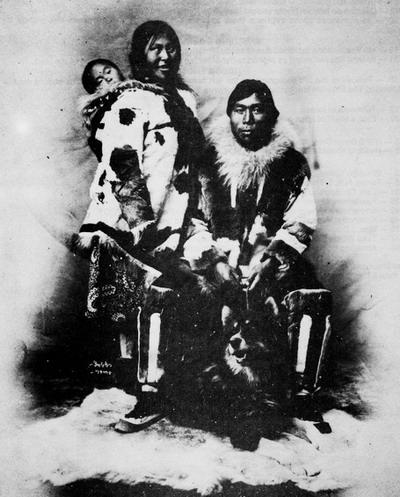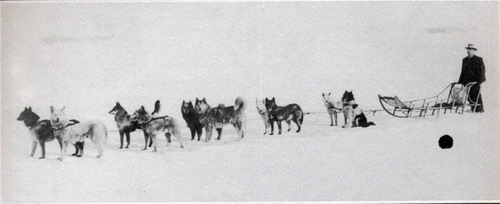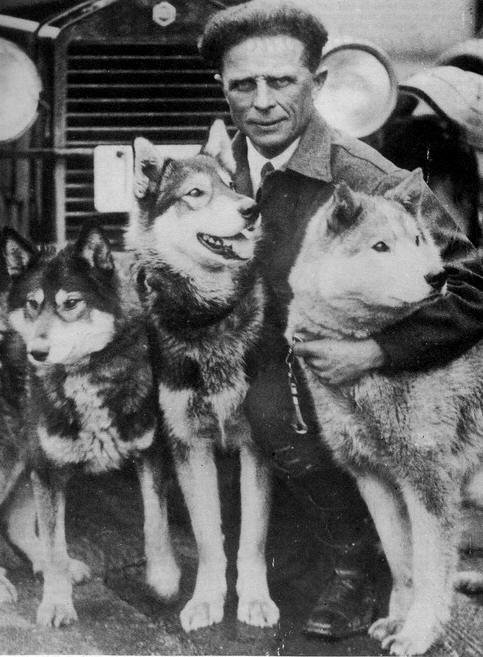

Together the Chukchi people and the Siberian Husky dog developed a
special relationship born of mutual need and nurtured by mutual
respect. Together, they thrived in virtual isolation for centuries
in the tundra before the outside world discovered and fell in love
with this magnificent dog. Although the present-day Siberian Husky
has changed since entering this country in the early 1900s, the
breed still maintains many of the qualities that made the Chukchi
sled dog such a prized possession.
The first known introduction of the Siberian Husky into the United
States was to Alaska by a fur trader named Goosack in 1908. Used for
sledding, these dogs started winning Alaskan races almost
immediately. The word was spreading about this superior strain of
sled dog in Siberia.

These are the dogs that started it all.
The first team of Siberian Huskies made its appearance in the All
Alaska Sweepstakes Race of 1909.
Later that same year a large number
of them were imported to Alaska by Charles Fox Maule Ramsay and his
team, driven by John "Iron Man" Johnson, won the grueling 408-mile
race in1910.

John "Iron Man Johson.
For the next decade Siberian Huskies, particularly
those bred and raced by Leonhard Seppala, captured most of the
racing titles in Alaska, where the rugged terrain was ideally suited
to the endurance capabilities of the breed. Leonhard Seppala became
famous for his outstanding racing Siberians.

Leonhard Seppala and Togo
One especially
well-known lead dog of Seppala's was Togo. Togo was Seppala's
full-time leader from about 1917 to 1925, although Seppala
frequently used him as a lead dog even before 1917. Togo was the
most famous and most traveled dog in Alaska, with many racing
victories to his credit. He was scrappy, fast, and brilliant.

Togo
Togo played
an instrumental role in saving many lives in an Alaskan village
(Nome). In January 1925, doctors realized that a potentially deadly
diphtheria epidemic was poised to sweep through Nome's young people.
The only serum that could stop the outbreak was in Anchorage, nearly
a thousand miles away. But the lone aircraft that could quickly
deliver the medicine had been dismantled for the winter. In
desperation, officials turned to a much lower-tech solution: moving
the medicine by sled dog.
The serum was sent by rail from Anchorage to the train stop closest
to the trail that led to Nome, which was Nenana. Yet, the distance
from Nenana to Nome was still more than 670 miles, and the serum had
to be transported across rough, potentially deadly terrain. More
than 20 mushers took part, battling temperatures that rarely rose
above 40 degrees below zero Fahrenheit and winds that sometimes blew
strong enough to knock over sleds and dogs. Reporters brought news
of the race to a world suddenly transfixed by the drama in the far
north.
Leonhard
Seppala's team, led by Togo, ran the longest and most dangerous leg
of the relay -- 91 miles, including a treacherous stretch over the
unpredictable ice of Norton Sound. Togo unerringly led his team into
a 40-mph gale -- the wind chill was about 80 below zero -- on the
way to the handoff to the next musher. In all, Togo and Seppala's
team covered more than 260 miles, out from Nome and back, in the
serum run


Incredibly, just six days later, on February 2, 1925, Gunner Kaassen
drove his heroic dog team into the streets of Nome. In the lead of
his team was a husky named Balto, whose furry face soon became known
around the world. A year later, in honor of the epic trek, admirers
erected a statue of Balto in New York City's Central Park. The
statue says:
Dedicated to the indomitable spirit of the sled dogs that relayed
antitoxin six hundred miles over rough ice across treacherous waters
through arctic blizzards from Nenana to the relief of stricken Nome
in the Winter of 1925. Endurance, Fidelity, Intelligence
Balto was suddenly a world-famous celebrity; for two years after the
serum run, the dog and some of his teammates traversed the
continental United States as part of a traveling show. After Balto
died in 1933, his body was preserved and displayed at Cleveland's
Natural History Museum. In 1995, a popular animated movie about
Balto was released, adding to his fame.
Many of today's Siberian Huskies have pedigrees tracing back to
Seppala's great racing dogs, including Siberians used primarily for
showing and Siberians used primarily for working.
Here are some pictures from Seppla's era.

